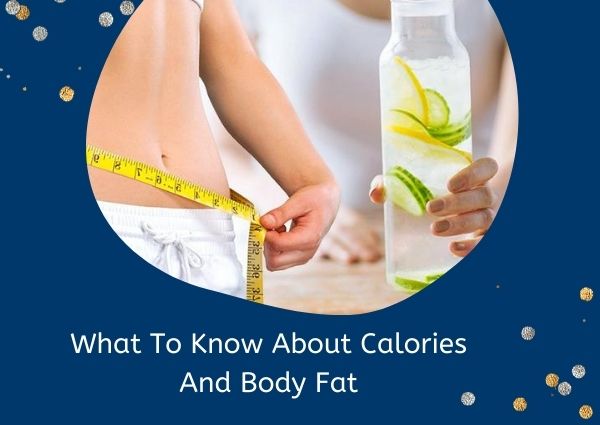What To Know About Calories And Body Fat
In the following article we’ll discuss an important topic that’s “What to know about calories and body fatr” let’s discuss in details:
In regard to food and the body, calories are units of energy that allow the body to work. Food provides this energy, a number of which the body stores and some of which it uses. As the body breaks down food, it further releases calories in the form of energy.
A concept first propagated by Max Wishnofsky said that there are approximately 3,500 calories in a pound (lb) of body fat.
Put simply, to lose 1 lb of body fat per week, people will actually need to have a deficit of around 500 calories per day. They can achieve this by consuming roughly 500 calories fewer than they are currently, by burning an extra 500 calories per day with exercise, or a combination of the two.
If the actually body takes in a lot of calories or burns too few, weight gain occurs quite evidently. This is because the body stores calories it doesn’t use as body fat. Organs including the brain, heart, lungs, liver, and kidneys account for roughly 80% of total daily energy use.
A research done recently calls this rule into question, concluding that it actually overestimates a person’s weight loss potential. The rule doesn’t take under consideration dynamic changes in metabolism, hunger, and satiety levels as weight loss occurs.
The National Institutes of Health (NIH) have developed a new, more accurate rule-of-thumb: Every 10 calorie decrease per day results in an eventual 1 lb loss. Only time will tell how long that weight loss takes, so patience and consistency is essential.
How fat works
These are fat cells, and they also occur alongside other kinds of cells and proteins. Fat cells contain lipids, including cholesterol and triglycerides.
Adipose tissue stores energy for the body to use and protects the organs. It also releases hormones that control many functions in the body, such as insulin sensitivity and appetite.
People with more body fat may experience something called leptin resistance, during which the body is less sensitive to the satiety hormone leptin. This, in turn, actually drives up hunger as well as food intake, thus making weight maintenance harder over time.
There are about 2 kinds of adipose tissue: white & brown. Brown adipose tissue is more metabolically active. It actually burns more calories and thus helps manage weight, insulin sensitivity, and the overall health to a much greater extent than white adipose tissue.
If people have excess body fat, it’s most frequently due to the very fact that their white adipose tissue has expanded.
Having an excessive amount of body fat can cause obesity and lead to many health problems, including diabetes, high blood pressure, and heart condition. Having insufficient body fat may also be harmful and result in health concerns like malnutrition and fertility issues.
How calories work
Research actually estimates that muscle burns calories at a rate of 10 to15 calories per kilogram (kcal/kg) per day. This amounts to 4.5–7 kcal/lb per day.
Muscle accounts for roughly 20% of total energy expenditure each day. For people with 20% body fat, body fat accounts for five energy expenditure.
So, people with more muscle tissue have a much higher metabolic rate. This means that they burn more calories and are actually able to maintain their body weight more easily.
How do we calculate calories?
Calories in food don’t amount to precisely the same measurement inside the body as outside the body.
That said, scientists measure the amount of caloric energy food contains by using a device called a bomb calorimeter.
By burning the food in this specific device, scientists can measure the heat released to actually find out the number of calories within the food.
This provides a figure for the total potential energy of food. However, this is not a true reflection of how the body will use the energy from food. The body cannot always use all of the calories that individuals consume.
Calorie losses can happen due to:
- urinating
- incomplete digestion of food
- having an ineffective metabolism
How people burn calories will depend upon their metabolism, digestion, and overall health and fitness levels.
A calorimetry machine can show precisely how many calories people burn when resting. This is called their basal metabolic rate. The machine measures CO2, which is nothing but the waste product from food the body burns as energy. Other accurate methods of estimating calorie expenditure use air or water displacement technology.
Using these tools, people can actually work out an accurate number for the calories that they burn during rest and exercise/activity. It is important recheck this figure every 3–6 months in order to understand how the body composition and calorie needs change over time.
People can use calorie-counting tools and fitness trackers so as to build a rough idea of how many calories they’re consuming and about how many they’re burning. However, this will not always be completely accurate.
Are different kinds of fat higher or lower in calories?
A gram (g) of fat contains 9 calories, which is over twice the actual number of calories in carbohydrates and proteins, both of which contain 4 kcal/g.
These are just simple rough estimates, however, since particular foods affect gut bacteria, insulin demands, and digestion as well as absorption differently. All of these factors affect the calories per gram of food and a person’s metabolic rate.
Certain fats are more healthful than others. Consuming too many trans and saturated fats can raise the levels of harmful cholesterol in the body and increase the risk of heart disease.
Monounsaturated as well as polyunsaturated fats are actually good for the body. Some of the good sources of these fats include nuts, seeds, vegetables and oily fish.
The body needs a certain amount of healthful fat to function properly. Furthermore, research suggests that although there’s no single dietary macronutrient plan which will work for everyone because of individual needs, majority of health experts recommend the following amount of carbohydrates, proteins, as well as fats for a balanced diet:
- Healthy fats: 20–35% of calories
- Protein: 15–20% of calories
- Complex carbohydrates: The remaining percentage of calories

